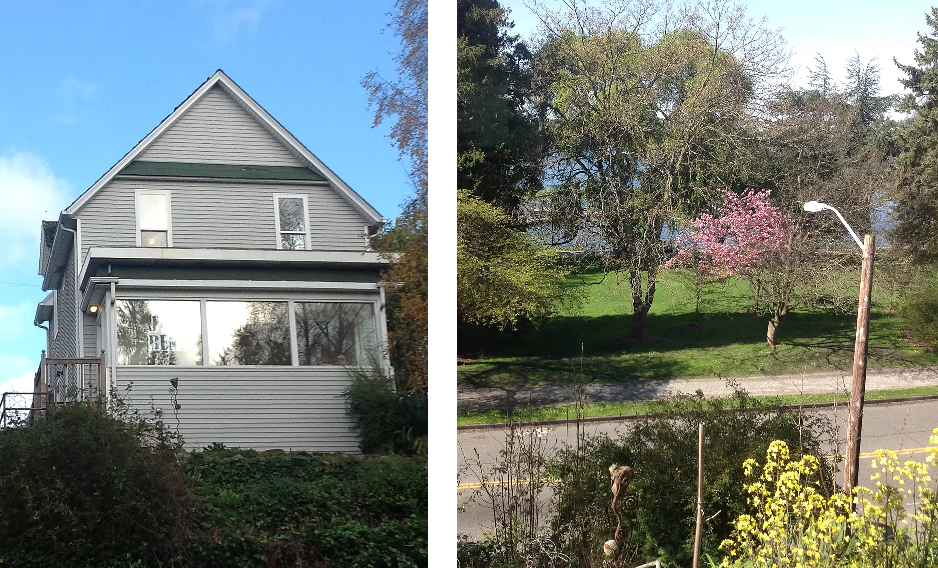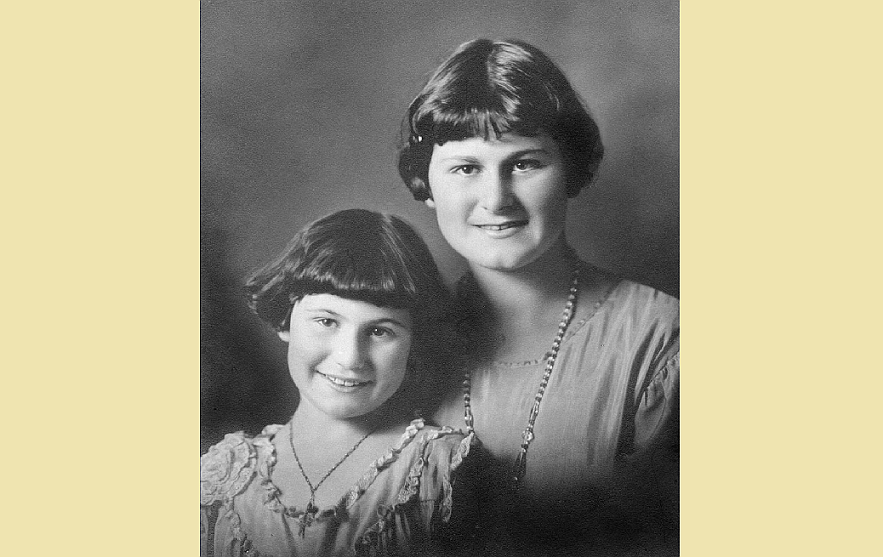7424 East Greenlake Way
March 1, 2024 at 3:26 p.m.
The year was 1923, and we had been in Seattle for about four years, when Mamma fell in love with the city block between Sunnyside and Latona, on East Green Lake Way. The middle houses on this block stood high above the street, supported by a 16-foot cement bulkhead, and each had a sweeping view over Green Lake. She walked by these houses every day on her way to the "District" to do her shopping. Green Lake, at that time, was a bustling little neighborhood with several grocery stores. There was a bank, a bakery, a hardware store, a dry-goods store, a theater, and a five-and-dime ... in short, just about anything needed by the local residents.
Our little house on Bagley was too small for our growing family. The attic had been partitioned to make a room for Florence and me, and Daddy had cut a dormer window into the roof of the other half to bring light into Jack's bedroom, but all of the rooms in the house were tiny. Mother longed for more space. Also, coming from the mountains of Eastern Washington had accustomed her eyes to a distant outlook, and she wanted that view over the lake.
One day there was a "For Sale" sign on her favorite house of all, 7424 East Green Lake Way, smack in the middle of "her" block, a two-story house with a porch across the entire front, topped by a balcony with a sturdy railing. The price was $2,500, with $500 to be paid down. She wanted that house! Daddy said, as he always did, "Well, Marion (his own, private name for her. Her name was Mary Annie), if you think we can pay for it, go ahead." Daddy had great faith in Mother's ability in money matters. Even when there was very little income, she managed to put something aside for the "rainy day" that never failed to come.
The Bagley house sold to some people named "VanPelt" and their down payment served as our down payment on the new house. The $25 we collected monthly on VanPelt's contract would, in turn, make the monthly payment for us. Where the money would come from if VanPelts defaulted was a question, but they would face that problem if, or when, it came. Dad had a job with a construction company on a fairly steady basis ... as steady as a job could be in a trade that shut down completely when the weather was bad.
They took the chance.
Mom's dream house was far from new, being built in 1906, but it was much bigger than the house on Bagley, so we now had room to stretch out. There was a large kitchen, a good-sized bathroom, a fair sized living room and dining room, and an adequate bedroom on the first floor, with an unfinished attic above.
Mamma scrounged an old, blue, discarded, stage curtain from the neighborhood theater and draped it over a long rope to divide the attic until the day that we could make proper rooms up there. Florence and I slept in the back half and Jack's bed was in the front part, which included the door to the balcony.
That attic was cold! I was glad to share a bed with Florence so that we could keep each other warm on freezing nights. The only heat-providers in the whole house were a tall, cast-iron pot-bellied heat stove in the dining room, and a wood-and-coal cookstove in the kitchen.
A real joy in our new location was having the Green Lake Library in the very next block. From early childhood, Mom loved to read and she passed that passion on to her children. Her formal education had stopped with third grade, but she carried on her quest for knowledge through borrowed books. She pushed us into the reading clubs sponsored by the library, and expected us to win recognition for our participation. We seldom disappointed her. It was our passion, too.
Daddy wanted a place for a workbench and his tools, so he hand-dug a full basement under the house, shoring up under the floor joists as he went along. Dad located a neighbor who wanted to even out his lot, so, as the dirt came out of the cellar it was wheeled half a block down our alley and dumped onto their lot, wheel barrowful by patient wheel barrowful. Florence and I helped with the digging, too, making piles of soil for Dad to haul out. Jack had a steady, after-school-and-Saturday job, so he helped on Sunday.
When the 50 x 30-foot excavation was finished to a depth of about 10 feet, Dad decided that as long as the house was up on braces and jacks we might as well move it six feet farther back on the lot to gain some front yard that wasn't steep bank. We dug 6 feet by the width of the house into the back yard. Dad moved the two-story building with borrowed house jacks, using smoothly round logs as rollers. He borrowed a cement mixer and we ended up with a first-class, concrete basement.
Then, we acquired a furnace, the first we had ever had. It was a forced-air coal burner with only one outlet, a three-foot-square metal grate, where the hot air came up through an l8-inch round vent in the center and cold air was drawn back down through openings around the edges. This grate was in the floor between the living room and dining room and those rooms were nice and cozy.
Next, he constructed an eight-foot-square coal bin in one corner of his new basement. He built himself a workbench and proceeded to remodel the attic.
There were two large bedrooms and one tiny one, which was supposed to be mine. I kept my clothes in my new closet, but Florence and I continued to sleep together since we never did get any heat upstairs. On winter mornings, I remember grabbing my school clothes and racing downstairs to stand on the furnace grate to get dressed. My flannel nightgown, still buttoned around my neck but with my arms inside, would balloon around me with the heated air, while I put on my underclothing, all the while being very careful not to step on the hot center of the vent.
The “new” house was a place we all loved to be. Mom’s first move every morning was to go out onto the big front porch and look out over the lake. In 1923, there was an unobstructed view of the whole body of water, with the rackety streetcar circling it just across the street. Our house, sitting atop the 16-foot retaining wall and the sloped front yard above that, was about 25 to 30 feet above the street level, so we felt like “King of the mountain.”
Thus, Green Lake became our front yard, our playground, and our source of daily pleasure. Green Lake was now “our lake."
 Dorothea Nordstrand's family bought this house across from Green Lake in 1923 for $2500. Zillow shows the current value at $1,377,400. Before all the trees grew up, the family had an unrestricted view across the lake.
Dorothea Nordstrand's family bought this house across from Green Lake in 1923 for $2500. Zillow shows the current value at $1,377,400. Before all the trees grew up, the family had an unrestricted view across the lake.





